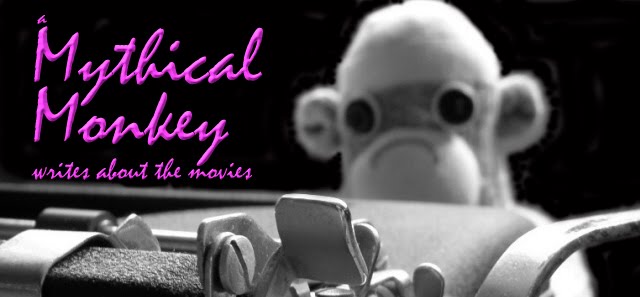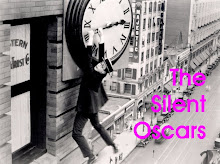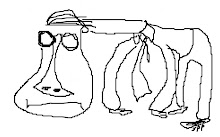 If choosing the best screenplay of the year were simply a question of counting up the quotable lines, Animal Crackers would be the hands-down winner for 1930-31. Not only did that movie give us Groucho Marx's most famous monologue—a description of the most inept African safari of all time—but it also included the "Take a letter to my lawyer" routine, the "Strange interlude" bit, Groucho's signature song "I Must Be Going," Chico's first piano performance of "I'm Daffy Over You" and some of the best work of Harpo's career.
If choosing the best screenplay of the year were simply a question of counting up the quotable lines, Animal Crackers would be the hands-down winner for 1930-31. Not only did that movie give us Groucho Marx's most famous monologue—a description of the most inept African safari of all time—but it also included the "Take a letter to my lawyer" routine, the "Strange interlude" bit, Groucho's signature song "I Must Be Going," Chico's first piano performance of "I'm Daffy Over You" and some of the best work of Harpo's career.In adapting the stage play that he and George S. Kaufman (with songs from Bert Kalmar and Harry Ruby) had written two years before, Morrie Ryskind retained the best jokes and the bare structure of the story, and jettisoned as much of the connective tissue as he could, but Animal Crackers never quite escapes the staginess of its origins and even if one of the supporting characters and I share the same name, I get a bit restless waiting through the dull stretches of creaky plot contrivances for another of the Marx Brothers' wonderful comedy routines. It's not much of a knock considering how often these great routines pop up, but in a year loaded with great screenplays—not just my nominees, but also The Dawn Patrol (John Monk Saunders), M (Fritz Lang and Thea Harbou), The Front Page (Charles Lederer and Bartlett Cormack) and The Public Enemy (Harvey Thew)—it's just enough of a flaw to make me look elsewhere for the best screenplay of 1930-31.
 Instead, the award goes to René Clair for his delightful and inventive musical comedy, Le Million. The story is tight and precisely put together, the songs and dialogue are witty and memorable, and the resulting comedy is as light and frothy as a glass of cold champagne.
Instead, the award goes to René Clair for his delightful and inventive musical comedy, Le Million. The story is tight and precisely put together, the songs and dialogue are witty and memorable, and the resulting comedy is as light and frothy as a glass of cold champagne.Le Million is the story of a struggling artist (René Lefèvre), in debt to his landlord and every shop owner in town, who discovers he has won the lottery—if only he can find the ticket. He remembers it's in the pocket of a jacket he left with his fiancee (Annabella), but she's given the jacket to a beggar (Paul Ollivier) on the run from the police who then sells the jacket in a thrift store to an opera singer who thinks it's just perfect for his role in La Boheme. Soon everybody is scrambling to get their hands on that jacket, a chase that climaxes in an on-stage scrum in the middle of the tenor's performance. Le Million influenced the title sequence of A Night at the Opera, and as a comedy, it can stand comfortably alongside the Marx Brothers' classic. It really is that good.
And if that was all there were to it, Le Million would still be one of the best movies of the year. That Clair also takes time, as the characters race around at a non-stop clip, to explore two of his favorite themes, the outsize role of money in society and the fragile nature of love, makes Le Million one of the best movies of any year, a deserving award winner.
 Clair gets great mileage out of the deference we pay to money and the people who have it regardless of their worth as human beings, and we laugh at the contortions of the shopowners to ingratiate themselves to a man they had just minutes before been chasing through the streets. Clair also shows us the lengths supposedly respectable people will go to get their hands on money they aren't entitled to, such as the ironically-named Prosper (Jean-Louis Allibert) who lets his friend the artist sit in jail just to increase his chances of getting to the lottery ticket first.
Clair gets great mileage out of the deference we pay to money and the people who have it regardless of their worth as human beings, and we laugh at the contortions of the shopowners to ingratiate themselves to a man they had just minutes before been chasing through the streets. Clair also shows us the lengths supposedly respectable people will go to get their hands on money they aren't entitled to, such as the ironically-named Prosper (Jean-Louis Allibert) who lets his friend the artist sit in jail just to increase his chances of getting to the lottery ticket first.As for the beggar who took loan of the jacket then sold it, he turns out to be Grandpa Tulipe, a master criminal who leads a well-organized band of highly-efficient thieves. But even they aren't content merely to steal, they feel compelled to dress up their base impulses with the same sort of respectable lies Bernie Madoff no doubt told himself:
"We are the foot soldiers of inequality!
We take back the spoils of social injustice!
And under the watchful eye of the police,
We redistribute wealth and private property."
 Clair concludes that "money isn't everything" but then adds this telling postscript:
Clair concludes that "money isn't everything" but then adds this telling postscript:"So say folks who are intelligent
To folks who haven't got a cent.
We'll believe what they say,
When they give all their money away."
 The second of Clair's favorite themes, that along with the notion that pos- sessions are a trap, real love is fragile and fleeting and not a game human beings are really adept at, could have become the stuff of a pretty conventional romantic comedy but for Clair's skill at spinning out the courtship. "We're just sort of engaged," the artist tells the beautiful model in his arms after his fiancee has caught them in an embrace. The fiancee herself is an outrageous flirt and isn't sure she wants to help him even of it does mean riches for them both. As expected, the two reunite and break apart and reunite and break apart throughout the movie, but it's only while they're trapped on stage behind a piece of scenery while the tenor and the coloratura sing of love that they reveal to each what's really in their hearts.
The second of Clair's favorite themes, that along with the notion that pos- sessions are a trap, real love is fragile and fleeting and not a game human beings are really adept at, could have become the stuff of a pretty conventional romantic comedy but for Clair's skill at spinning out the courtship. "We're just sort of engaged," the artist tells the beautiful model in his arms after his fiancee has caught them in an embrace. The fiancee herself is an outrageous flirt and isn't sure she wants to help him even of it does mean riches for them both. As expected, the two reunite and break apart and reunite and break apart throughout the movie, but it's only while they're trapped on stage behind a piece of scenery while the tenor and the coloratura sing of love that they reveal to each what's really in their hearts. This doesn't even touch on the fact that Le Million made the most innovative use of sound to date in the Early Sound Era, introducing ideas that still crop up in movies and television. But that's the subject of my next essay, "Achievements In The Use Of Sound: René Clair's Le Million."
This doesn't even touch on the fact that Le Million made the most innovative use of sound to date in the Early Sound Era, introducing ideas that still crop up in movies and television. But that's the subject of my next essay, "Achievements In The Use Of Sound: René Clair's Le Million."Despite how unappealing the idea of watching a seventy-eight year old French musical comedy might sound to a casual movie fan, Le Million really is a Saturday night movie, full of slapstick and sightgags, and the only thing that keeps me from naming it the best Fun-Stupid movie of 1930-31 is my reluctance to task your patience with subtitles. But if you're willing to take a chance then I'm telling that this is the one French movie you can brag to friends about watching, understanding and enjoying.
Or to put it another way, Katie-Bar-The-Door started out watching Le Million I think mostly to humor me, became completely enchanted with it and wound up talking about it for days afterwards. In fact, she's the one who urged me to choose it for best screenplay over it's better-known competition. And she was right.
 Born in Paris in 1898 as René-Lucien Chomette, René Clair worked as a journalist and an actor before directing his first film in 1924, Entr'acte, an exercise in Dadaism that included jumbled footage of Paris and a coffin that runs away from a funeral. He achieved his first lasting success in 1930 with Under The Roofs Of Paris, an amiable comedy about the intersecting lives of four Parisians. Convinced there was no point in merely replicating theater or radio performances on film, it was in this film that Clair first began to experiment with the new sound technology. As I will discuss at more length in my next essay, Clair's use of sound in Le Million was both inventive and influential and was a landmark achievement of the Early Sound Era.
Born in Paris in 1898 as René-Lucien Chomette, René Clair worked as a journalist and an actor before directing his first film in 1924, Entr'acte, an exercise in Dadaism that included jumbled footage of Paris and a coffin that runs away from a funeral. He achieved his first lasting success in 1930 with Under The Roofs Of Paris, an amiable comedy about the intersecting lives of four Parisians. Convinced there was no point in merely replicating theater or radio performances on film, it was in this film that Clair first began to experiment with the new sound technology. As I will discuss at more length in my next essay, Clair's use of sound in Le Million was both inventive and influential and was a landmark achievement of the Early Sound Era.Clair made three more movies in France, including the classic À Nous La Liberté, then relocated to Hollywood in 1935 where he worked until after World War II. His Hollywood films aren't on par with his best French work, but he did direct I Married A Witch and Then There Were None, both critically-acclaimed box office hits. During his career, he directed thirty movies, his last in 1965, and died in France in 1981 at the age of eighty-two.
Acknowledgment: Usually when I write these essays, I sit in front of my DVD player (or VCR or YouTube) and take notes in longhand, transcribing quotes and making my usual witty observations. But Katie and I got Le Million from Netflix and I sent it back before it occurred to me that I would need to watch it again to write this lengthy post about it. I don't know what I was thinking.
So I scoured the internet for usable quotes (the witty observations, fortunately, were firmly embedded in my head), came up empty at the usually reliable Internet Movie Database, then found a very useful and interesting blog called "The Criterion Contraption," written by Matthew Dessem who is attempting to watch and review every movie in the Criterion Collection catalogue. Obviously, he's even crazier than I am, which is saying something, and my hat's off to him. It's a good blog and if you're interested in the sort of movies Criterion sells on DVD and are looking for an in-depth review, I recommend you head on over there.
Anyway, his review of Le Million is chock full of good quotes, not to mention several screen captures of the movie itself, and I relied on his good work as a research tool. Hopefully, he and you are okay with that.













































